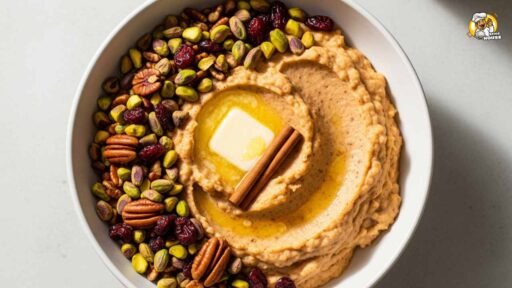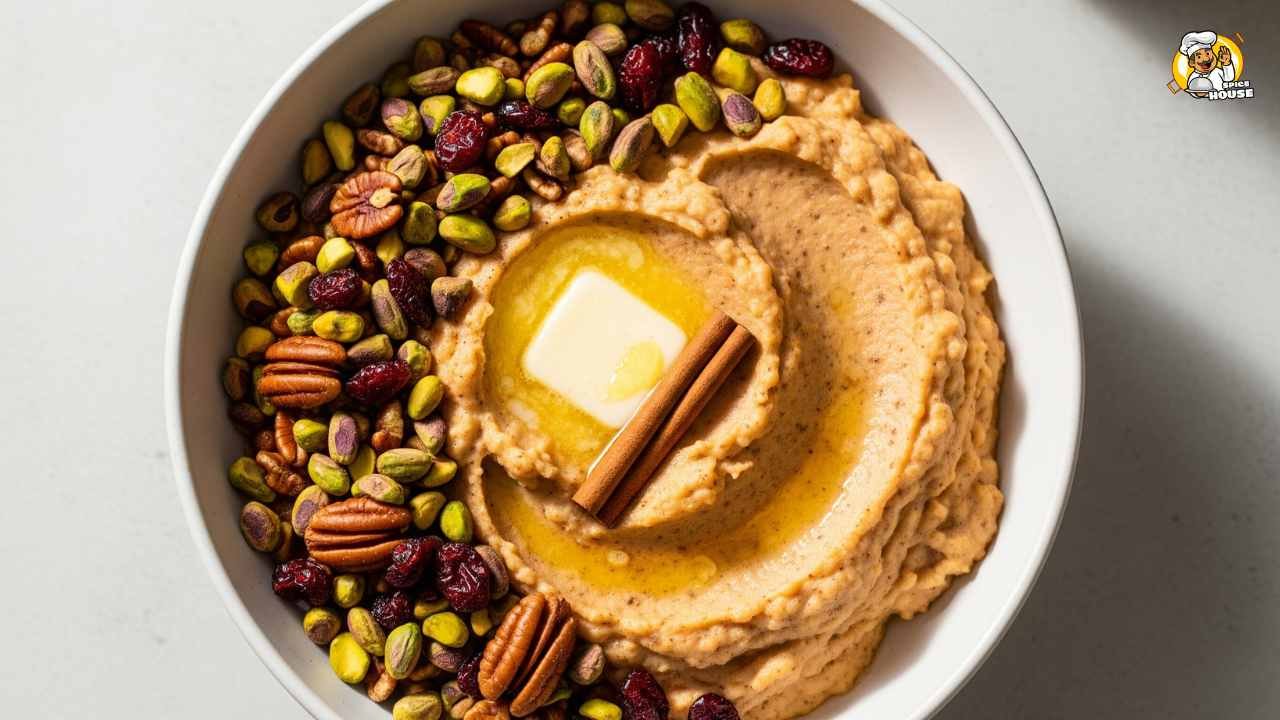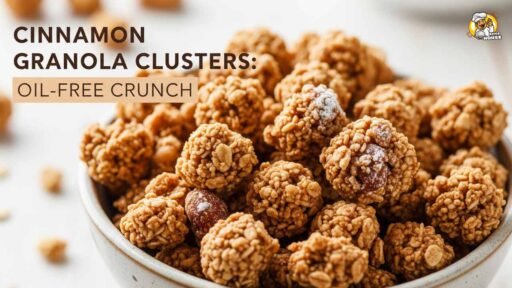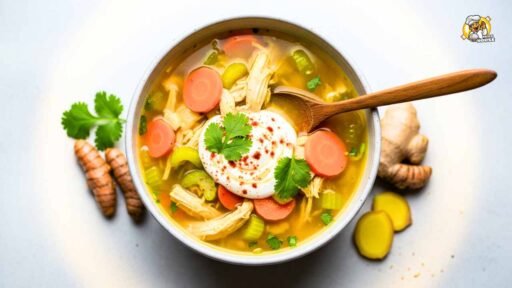Butter prices spiked roughly 26% in 2022, according to the U.S. Bureau of Labor Statistics, and they’ve stayed elevated. That sticker shock met a wellness wave head-on, and a quiet shift followed: home cooks started replacing fat with flavor. One dish sits right at the center of this trend—Cinnamon Sweet Potato Mash—with a no-butter trick that actually tastes richer than it sounds.
Here’s the thing: some chefs insist butter is non-negotiable for mashed sides. Dietitians roll their eyes and point to fiber, potassium, and vitamin A doing the heavy lifting if you ditch the dairy. In between, spice makers see an opening. Investors watch McCormick & Co.—a bellwether for the “flavor economy”—as consumers, restaurant R&D teams, and grocery private labels all lean on cinnamon and friends to deliver comfort without the cream. That puts employees across spice, dairy, and plant-based brands squarely in the mix as this preference reshapes kitchen habits and product roadmaps.
The Data:
-
According to USDA FoodData Central, a medium baked sweet potato (about 130–150 grams) delivers roughly 100 calories, 4 grams of fiber, over 400% of the Daily Value for vitamin A as beta-carotene, and meaningful potassium—all before any butter or sugar lands on the plate. That’s a nutrient-dense base for a “flavor-first” mash.
-
BLS CPI data show retail butter prices jumped about 26% in 2022 year-over-year. Prices cooled a bit in 2023 but remain higher than pre-pandemic levels. In other words, butter is still a splurge, especially at scale for restaurants and retailers.
-
The global cinnamon market has been posting steady growth—industry trackers estimate a high single- to low double-digit CAGR through the end of the decade, fueled by home-cooking and wellness positioning. McCormick has told investors repeatedly that “flavor is an advantaged category,” and its consumer segment momentum during peak home-cooking periods backs that up.
Cinnamon Sweet Potato Mash: No-Butter Trick (Step By Step Guides)
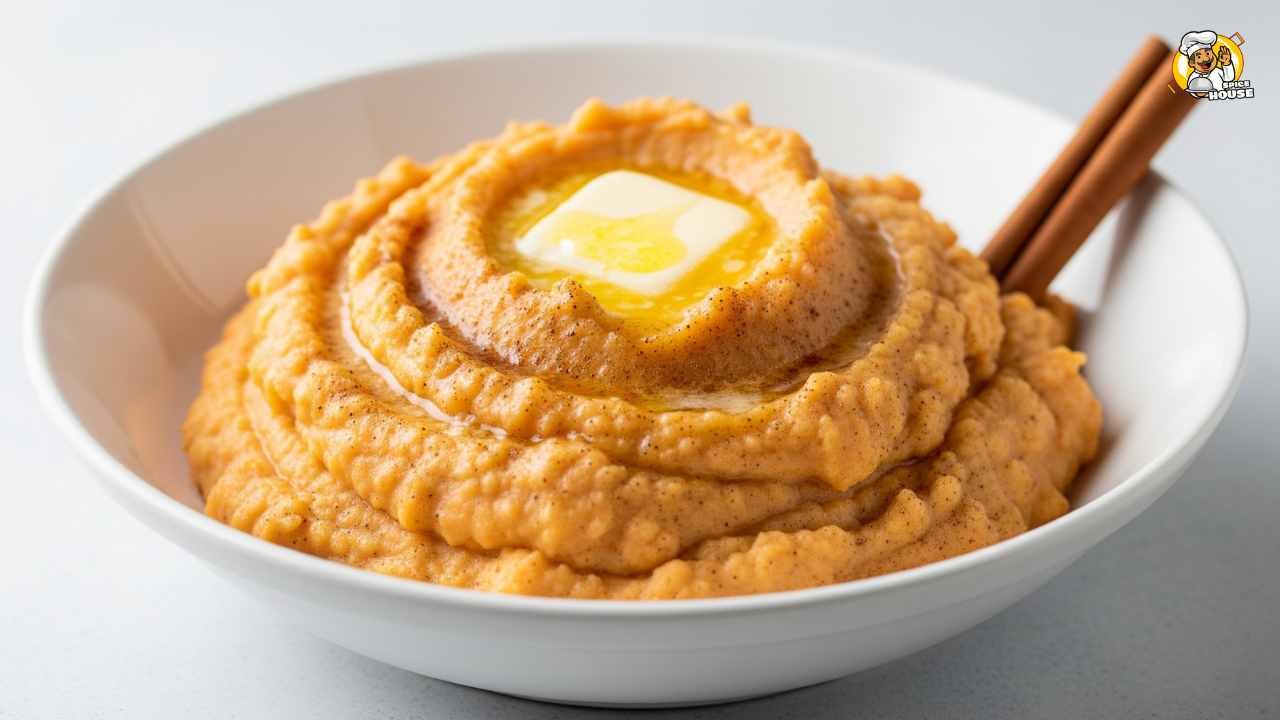
What follows are pro-level, no-butter techniques designed for home kitchens, plus precise ratios and make-ahead advice. Each step builds on the last. The goal: velvety, cinnamon-forward sweet potato mash that eats like a luxury side without leaning on dairy.
1. Pick, Cook, and Protect the Starch
Start with starch management. Sweet potatoes (preferably Garnet or Jewel) carry a mix of amylose and amylopectin that sets the mash’s body. You want them tender but not waterlogged. Choose medium, heavy-for-size tubers with tight skins—avoid gashes and sprouts. Plan on 2 pounds (900 g) for 4 servings.
Cooking method is everything:
-
Steam-roast: Halve lengthwise, rub cut sides with a light film of oil, place cut-side down on a sheet pan, add 2 tablespoons water, cover tightly with foil, and bake at 400°F (205°C) for 35–45 minutes until a knife slides through. This traps moisture inside the potato instead of pulling it in from boiling water.
-
Microwave shortcut: Prick whole potatoes and microwave on high 8–12 minutes, rotating once, until soft. Rest 5 minutes. The skins peel like a jacket.
-
Boil with skin on (if you must): Keep skins on to limit water absorption; drain thoroughly and return to the hot pot to steam off excess moisture for 2–3 minutes.
Why this matters: gentler cooking limits free water and preserves natural sweetness. Sweet potatoes contain enzymes that slowly break down starches to sugars as they cook; dry heat or steam-roasting promotes those conversions for deeper caramel notes. Cinnamon complements that profile, adding warmth that reads as “sweet” without added sugar. Don’t peel before cooking; you’ll lose flavor and invite water in. Once tender, scoop the flesh into a warm bowl, cover, and hold while you prep your no-butter emulsion.
Pro tip: If you’re cooking ahead, cool the cooked flesh fast (sheet pan, single layer) to dodge gumminess later. Then reheat gently with your emulsion (see Step 2). That “set-then-emulsify” timing gives you fluff without glue.
2. Build a Butterless Emulsion That Eats Rich
Fat’s job in mash isn’t just taste—it’s texture. Butter coats starch, carries aroma, and creates shine. We can fake all three with a smart emulsion built from extra-virgin olive oil, a touch of nut or seed butter, and hot, unsweetened plant milk. The nut/seed butter adds emulsifiers and body; the plant milk thins and helps aromas bloom.
Master ratio for 2 lb (900 g) cooked sweet potato flesh:
-
3 tablespoons (45 ml) extra-virgin olive oil, warmed
-
1 tablespoon (15 g) tahini or cashew butter
-
1/3 cup (80 ml) hot oat, almond, or soy milk, unsweetened
-
1 teaspoon (5 ml) apple cider vinegar or sherry vinegar
-
1 teaspoon fine sea salt, plus more to taste
Technique:
-
Warm the oil and plant milk separately; heat coaxes aroma from spices later and keeps the mash hot.
-
In a small bowl, whisk the tahini into the warm oil until glossy. Stream in the hot plant milk, whisking to form a loose emulsion. Add the vinegar and salt.
-
Pour half the emulsion over the hot sweet potatoes. Mash with a potato masher or, for a silkier texture, use a ricer first, then fold with a spatula. Add more emulsion until it’s plush, not soupy.
Texture guardrails: Overworking sweet potatoes—especially with a food processor—can shred cells and release too much starch, leading to gluey paste. Mash by hand or fold gently. If the mash tightens as it sits, loosen with a splash of hot plant milk.
Alternates:
-
For ultra-light: whip 2–3 tablespoons aquafaba (chickpea liquid) to soft peaks and fold in at the end.
-
For coconut lovers: sub 1/4 cup (60 ml) warm light coconut milk for part of the plant milk and skip the vinegar.
Aromatics ride fat; structure rides starch. This mix gives you both.
3. Bloom Cinnamon (And Friends) the Right Way
Cinnamon is the headline act, but it sings louder when you bloom it—gently toasting it in fat to draw out volatile oils. Do this fast, then add it to the mash. Use Ceylon cinnamon for soft, floral notes or cassia for bolder, familiar “red hot” warmth. Many pros blend both.
For 2 lb mash:
-
1 to 1 1/2 teaspoons ground cinnamon
-
Optional boosters: 1/8 teaspoon ground allspice, a pinch of clove, or 1/4 teaspoon smoked paprika for savor
Technique:
-
In a small skillet over low heat, add 1 teaspoon olive oil from your emulsion. Sprinkle in the cinnamon (and any boosters). Stir constantly 30–60 seconds until fragrant—no smoke, no darkening. If it smokes, start over; bitter is not the goal.
-
Immediately scrape the spices into your emulsion and whisk. Hot fat locks in aroma, and the emulsion disperses it evenly.
Why blooming works: cinnamon’s key aromatics (like cinnamaldehyde) are oil-soluble. Heat and fat carry them across the mash, so every bite smells like you worked harder than you did. Layering a whisper of savory spice (paprika, allspice) reins in sweetness and creates a “mature” profile that doesn’t need butter as a crutch.
Grind fresh if you can. Whole cinnamon sticks ground in a clean spice grinder release brighter top notes. If you only have pre-ground, keep it fresh: airtight jar, cool dark pantry, swap every 6–9 months.
Salt matters. Cinnamon wakes up with the right salt level. Taste, then taste again. If it reads flat, it likely needs a pinch more salt, not more spice.
4. Balance the Four Levers: Sweet, Salt, Acid, Heat
Without butter, balance takes center stage. You’ll get natural sweetness from the potatoes and cinnamon; your job is to frame it with salt, spark, and a bit of bite.
For a 2 lb mash, after mixing in the cinnamon emulsion:
-
Sweet: 1–2 teaspoons maple syrup—or skip if your potatoes are very sweet. You’ll be shocked at how little it takes.
-
Salt: Add in 1/4 teaspoon increments until the mash comes forward. Expect total salt around 1 1/4 to 1 1/2 teaspoons, depending on your plant milk and tahini.
-
Acid: 1 teaspoon sherry vinegar or lemon juice brings lift and cuts through starch. If using coconut milk, try 2 teaspoons lime juice and a pinch of zest.
-
Heat: 1/8–1/4 teaspoon Aleppo pepper or black pepper. You want warmth, not a spice bomb.
Umami cheat codes:
-
1 teaspoon white miso whisked into the emulsion adds backbone and savory length without reading as “miso.” If you’re nervous, start with 1/2 teaspoon.
-
1/2 teaspoon of soy sauce or tamari can replace some salt.
-
1 tablespoon of nutritional yeast adds a cheesy echo that many tasters associate with butter.
Texture accents:
-
Toasted pecans or walnuts, roughly chopped (1/3 cup), give contrast.
-
Orange zest (1/2 teaspoon) pairs with cinnamon for holiday energy.
-
A final drizzle of your best olive oil adds sheen and a “buttery” finish on the palate.
Taste in rounds. Let the mash sit 1–2 minutes between adjustments; hot starch mutes salt and acid at first. If your mash feels flat and you’ve salted enough, add a tiny splash of vinegar and one more pinch of cinnamon. This smells like a simple trick, but it’s the pro move that brings it home.
5. Pro Recipes, Variations, Make-Ahead, and Plating
Put the framework to work with three dialed-in, butter-free recipes. It all starts with 2 lb cooked sweet potato flesh and the emulsion base.
A) Classic Cinnamon Velvet Mash
-
Emulsion: 3 tbsp warm EVOO + 1 tbsp tahini + 1/3 cup hot oat milk + 1 tsp cider vinegar + 1 1/4 tsp fine sea salt
-
Spices: 1 1/4 tsp ground cinnamon bloomed in 1 tsp oil, 1/8 tsp allspice
-
Finish: 1 tsp maple syrup (optional), 1/8 tsp black pepper
Steps: Whisk emulsion, bloom spices, fold into hot potatoes, mash. Adjust salt and acid. Drizzle with 1 tsp oil to finish.
B) Savory Smoke & Spice Mash
-
Emulsion: 3 tbsp warm EVOO + 1 tbsp white miso + 1/3 cup hot unsweetened soy milk + 1 tsp sherry vinegar + 1 1/4 tsp salt
-
Spices: 1 tsp cinnamon, 1/4 tsp smoked paprika, a pinch of clove, bloomed
-
Finish: 1/4 tsp Aleppo pepper, 1/2 tsp orange zest, 1/3 cup toasted pecans
Steps: Bloom spices, whisk into emulsion with miso, fold into potatoes, mash lightly, finish with zest and nuts.
C) Coconut-Lime Cinnamon Mash
-
Emulsion: 2 tbsp warm EVOO + 1 tbsp cashew butter + 1/4 cup warm light coconut milk + 2 tbsp hot water + 2 tsp lime juice + 1 tsp salt
-
Spices: 1 tsp cinnamon, 1/8 tsp ground ginger, bloomed
-
Finish: 1 tbsp toasted coconut flakes, extra lime zest
Steps: Bloom cinnamon and ginger in oil, whisk with cashew butter and coconut milk, mash into potatoes, brighten with lime.
Make-ahead and reheat:
-
Make up to 2 days ahead. Chill quickly in a shallow container. To reheat, add a splash of hot plant milk and a teaspoon of oil on the stovetop over low heat, stirring until hot. Re-bloom a 1/4 teaspoon of cinnamon in a few drops of oil and fold in at the end to refresh the aroma.
-
Food safety: Cool to below 40°F within 2 hours; reheat to steaming hot before serving.
Plating like a pro:
-
Spoon into a warm, shallow bowl. Swipe the back of a spoon to create ridges. Dust with micro-grated cinnamon only if you want a visual signal—too much on top can get bitter. Finish with a fine thread of olive oil and a final pinch of flaky salt.
The People
Consumers started this pivot, but insiders are moving it faster. A corporate R&D chef at a national grocer told me, “We’re getting the same guest satisfaction scores with spice-forward, lower-fat sides if we nail texture. Seasoning is cheaper than dairy right now, and it’s a cleaner label.” A former flavor scientist at a leading spice maker put it even sharper: “We’re not selling cinnamon; we’re selling the butter you don’t need.” That line stuck with me.
Registered dietitians frame it in outcomes. “Sweet potatoes deliver fiber and potassium—two nutrients most Americans miss,” one RD said. “If you swap butter for olive oil and elevate with cinnamon, you keep the comfort and drop the saturated fat.” Culinary instructors echo the technique-first angle: bloom spices, build an emulsion, balance with acid. You can watch the skepticism fade at the tasting table.
On the investor side, McCormick & Co. keeps hammering a simple point on earnings calls: flavor is an advantaged category. When at-home cooking spikes, so do spice sales. That puts a tailwind behind blends that promise “butter-like” satisfaction without dairy. Meanwhile, restaurant operators have quietly adjusted, too. Pre-COVID, a seasonal sweet potato mash might have leaned on butter and cream. Today, more chains test plant-based, spice-led sides that hold better on the line and photograph beautifully. In kitchen labor markets this tight, an item that’s stable, reheat-friendly, and cost-controlled is gold. Sources say even old-guard steakhouse brands have trialed no-butter mashes for prix-fixe menus, though you won’t always see the phrasing printed on the card.
The Fallout
Real-world consequences flow across plates and P&Ls.
-
Consumers: You get a side that’s cheaper to make at home, often with a better nutrition profile. The technique rewards pantry smarts over luxury inputs. You’ll also see more grocery private-label blends geared to “bloom and fold” cooking—cinnamon-forward, low-sodium mixes designed for starchy veg.
-
Restaurants: Expect a broader adoption of spice-forward mashes that reheat without breaking. No cream means fewer separation issues in hot-hold and better performance in off-premise. Analysts now predict a more durable “flavor-led” menu development cycle as brands push for margin protection without sacrificing perceived value.
-
CPG and spices: This shift benefits spice companies and private labels. If you can sell the promise of richness with aromatic payoff, you defend volume even when consumers trade down from premium dairy. McCormick’s consumer business historically tracks with at-home cooking intensity; the more nights people cook, the more spice they buy. The no-butter mash is a micro case study of that dynamic. Expect more ready-to-bloom spice oils and sachets that take the guesswork out of the step you saw above.
-
Dairy: Butter doesn’t disappear. It moves to the center of the plate where it counts—finishing steaks, baking, and pastry. But sides? They’re getting leaner in terms of saturated fat. That’s not a crisis; it’s a portfolio rebalance. Producers may respond with clarified and cultured butter SKUs positioned as “a little goes further,” aiming to recapture share with intensity instead of volume.
-
Employees: On the ground, culinary teams are retraining to bloom spices correctly, and production planners are retooling batch specs to favor emulsions that don’t contain allergens like dairy. In spice plants, quality teams double down on grind size and volatile retention because the aromatics actually carry the dish now.
All of these points point to a broader pattern. Wellbeing trends and budget pressure are pushing cooks to wring more from aromatics and technique. If that sounds like a renaissance of craft over consumption, that’s because it is.
Closing Thought
Butter won’t vanish, but cinnamon and smart emulsions are stealing its lines. If flavor keeps winning the argument on cost, health, and satisfaction, will the next great holiday side be decided not by dairy, but by who blooms their spices best—and does that edge push spice makers like McCormick to behave more like sauce companies than seasoning brands?

